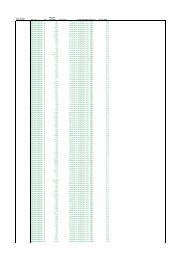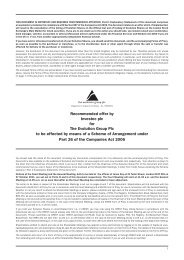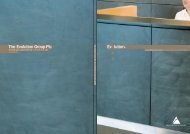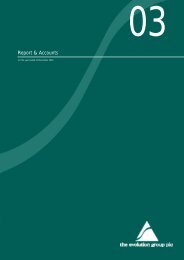Annual Report for the year ended 31 December 2008
Annual Report for the year ended 31 December 2008
Annual Report for the year ended 31 December 2008
Create successful ePaper yourself
Turn your PDF publications into a flip-book with our unique Google optimized e-Paper software.
Risk <strong>Report</strong>ing<br />
The Group Board receives a monthly risk report detailing market and credit<br />
risk exposures, operational risk incidents and losses and key risk indicators.<br />
in addition, <strong>the</strong> risk committee discusses significant exposures and reviews<br />
limit breaches or requests <strong>for</strong> temporary limit increases.<br />
(a) Management of Market Risk<br />
Market risk management seeks to identify and control <strong>the</strong> potential loss in<br />
value of Group assets arising from changes in market prices. The principal<br />
risk <strong>for</strong> <strong>the</strong> Group is an adverse change in equity prices. The risk<br />
Department’s role is to independently monitor, control and report this risk.<br />
it is important <strong>for</strong> senior management to be aware of <strong>the</strong> possible capital<br />
implications of an adverse movement in prices. stress tests provide<br />
an indication of <strong>the</strong> potential size of losses that could arise in extreme<br />
conditions. The stress tests approved by <strong>the</strong> risk committee are historical<br />
scenarios that show <strong>the</strong> profit & loss that would occur if <strong>the</strong> historic changes<br />
were to be repeated. These stress test results are calculated in near realtime<br />
and <strong>the</strong> end-of-day results are reviewed by <strong>the</strong> risk committee and <strong>the</strong><br />
Board of Directors. This stress test is used to determine whe<strong>the</strong>r <strong>the</strong> Group<br />
holds enough capital under pillar 2 of <strong>the</strong> capital requirements Directive.<br />
Equity Price Risk<br />
The Group is exposed to equity market risk in respect of its equity holdings.<br />
These comprise: (i) available-<strong>for</strong>-sale financial assets, (ii) trading portfolio assets<br />
and liabilities that result from market making, and (iii) derivatives. in conjunction<br />
with stress tests outlined above, a sensitivity analysis has been per<strong>for</strong>med<br />
on <strong>the</strong> Group’s exposure to equity risk. The analysis is based on <strong>the</strong> assumption<br />
that underlying equity prices had an increase/decrease of 10% with all o<strong>the</strong>r<br />
variables held constant at <strong>the</strong> <strong>year</strong> end. The results as outlined below, are<br />
only representative of <strong>the</strong> impact that is observed at <strong>the</strong> <strong>year</strong> end, and not<br />
of <strong>the</strong> impact that was observed during <strong>the</strong> <strong>year</strong>. This occurs due to a varying<br />
portfolio throughout <strong>the</strong> <strong>year</strong>.<br />
i) Available-<strong>for</strong>-sale financial assets<br />
The Board continues to review <strong>the</strong> per<strong>for</strong>mance of existing available-<strong>for</strong>-sale<br />
financial assets in <strong>the</strong> Group’s portfolio and realises <strong>the</strong>se investments when<br />
deemed appropriate.<br />
The Group does not consider any of <strong>the</strong> assets to be impaired.<br />
For available-<strong>for</strong>-sale financial assets, a 10% increase/decrease in equity<br />
prices would result in an increase/decrease respectively in equity reserves<br />
of £106,000 (2007: £68,000).<br />
ii) Trading portfolio assets and liabilities that result from market making<br />
The risk Department monitors <strong>the</strong> market risk limits as laid down in <strong>the</strong> Trading<br />
policy statement. An automated system notifies <strong>the</strong> department whenever<br />
a limit is breached and <strong>the</strong> risk Department <strong>the</strong>n have a discussion with<br />
<strong>the</strong> trader be<strong>for</strong>e notifying senior management as to how <strong>the</strong> breach will<br />
be resolved. The whole process is logged and is fully auditable so that it is<br />
possible, <strong>for</strong> example, to analyse limit breach patterns or limit utilisation.<br />
A 10% increase/decrease in equity prices on trading portfolio assets would<br />
increase/decrease profit in <strong>the</strong> income statement by £503,000 (2007:<br />
£1,777,000). A 10% increase/decrease in equity prices on trading portfolio<br />
liabilities would decrease/increase profit in <strong>the</strong> income statement by<br />
£426,000 (2007: £605,000) respectively.<br />
notes to tHe FinanCial statements CONTINuED<br />
FOR THE YEAR ENDED <strong>31</strong> DECEMBER <strong>2008</strong><br />
iii) Derivatives<br />
Derivatives mainly consist of options and warrants received in lieu of<br />
corporate finance fees. Management of market risk in respect of derivatives<br />
is through active involvement of senior management under <strong>the</strong> supervision<br />
of <strong>the</strong> Board of Directors.<br />
The Group will occasionally use derivatives to hedge its trading portfolio.<br />
All such positions are discussed with senior management and independently<br />
monitored by <strong>the</strong> risk Department.<br />
Additionally, non-regular way trades at <strong>the</strong> period end give rise to derivative<br />
<strong>for</strong>ward contracts as a result of <strong>the</strong> change in market value from <strong>the</strong><br />
contract (trade) date to <strong>31</strong> <strong>December</strong> <strong>2008</strong>.<br />
WDB capital uK equity Fund limited holds cFDs and <strong>the</strong>se are brought into <strong>the</strong><br />
Group on consolidation. These positions are held on a matched basis and are<br />
closed out on a monthly basis, hence do not provide <strong>the</strong> Group with any material<br />
exposure to equity risk. At <strong>the</strong> <strong>year</strong> end <strong>the</strong>re were no open cFD positions.<br />
The impact of a 10% increase in equity prices on derivatives would increase<br />
profit in <strong>the</strong> income statement by £111,000 (2007: £257,000). A 10%<br />
decrease in equity prices would decrease profit in <strong>the</strong> income statement<br />
by £99,000 (2007: £232,000).<br />
Foreign exchange risk<br />
The following table summarises <strong>the</strong> Group’s currency exposure arising from<br />
unmatched monetary assets or liabilities not denominated in <strong>the</strong> Group’s<br />
functional currency of <strong>the</strong> Group entity:<br />
<strong>2008</strong> 2007<br />
£’000 £’000<br />
net assets/(liabilities)<br />
euros 110 496<br />
us Dollar 566 1,223<br />
hong Kong Dollar 7<strong>31</strong> 642<br />
swiss Franc 216 89<br />
o<strong>the</strong>r currencies 140 (83)<br />
1,763 2,367<br />
The Group’s activities are primarily denominated in sterling and it <strong>the</strong>re<strong>for</strong>e<br />
has minimal <strong>for</strong>eign exchange risk. The majority of transactions denominated<br />
in a <strong>for</strong>eign currency that would expose <strong>the</strong> Group to currency risk are economically<br />
hedged immediately, normally in <strong>the</strong> spot market. The Group does not enter<br />
into <strong>for</strong>ward exchange contracts <strong>for</strong> hedging anticipated transactions.<br />
Based on <strong>the</strong> Group’s <strong>year</strong> end net assets dominated in non sterling currencies<br />
<strong>the</strong> impact of a 10% streng<strong>the</strong>ning or weakening in sterling against major<br />
currencies would result in a gain or loss of £176,000 (2007 £237,000).<br />
During <strong>2008</strong> <strong>the</strong> Group was also exposed to <strong>for</strong>eign exchange movements<br />
with <strong>the</strong> WDB capital uK equity Fund limited. however, <strong>the</strong> Group’s interest<br />
in <strong>the</strong> fund reduced from 94.79% to 50.20% during <strong>2008</strong>. in 2009 <strong>the</strong><br />
Group expects its interest in <strong>the</strong> fund to reduce below 50% and <strong>the</strong>re<strong>for</strong>e<br />
will no longer be 100% consolidating WDB capital uK equity Fund limited’s<br />
results. The impact of <strong>the</strong> continued dilution of <strong>the</strong> Group’s interest in WDB<br />
capital uK equity Fund limited, and converting to equity associate accounting<br />
(in accordance with iAs 28) reduces fur<strong>the</strong>r <strong>the</strong> Group’s exposure to <strong>for</strong>eign<br />
exchange movements.<br />
51






![2. Front continued [c87307] - The Evolution Group PLC](https://img.yumpu.com/19604468/1/184x260/2-front-continued-c87307-the-evolution-group-plc.jpg?quality=85)


